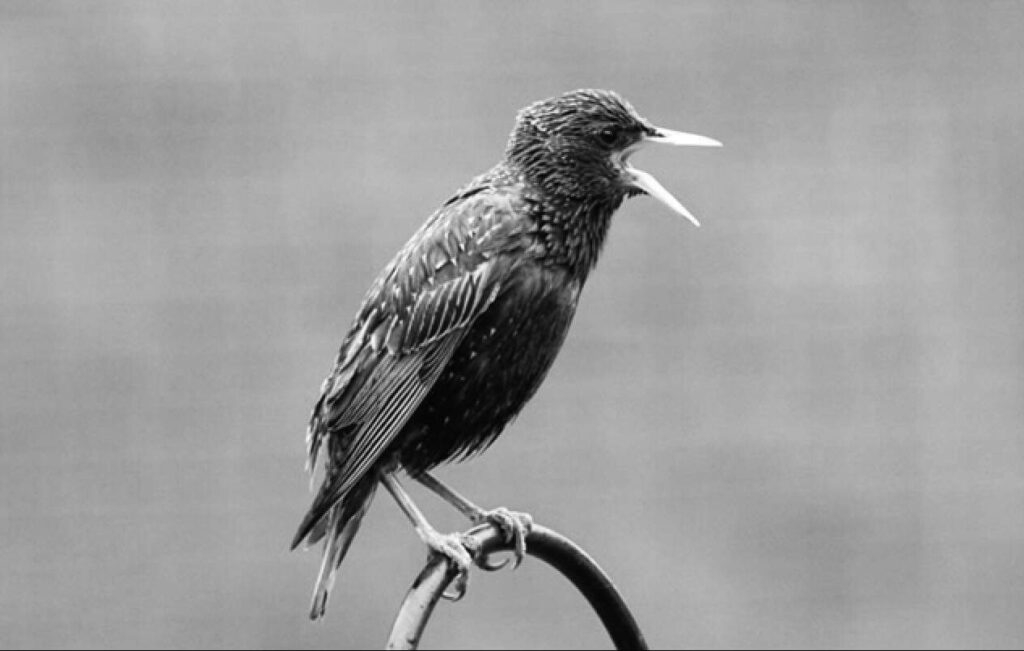
Back Yard Bird Watching
When I decided to write about Starling (Sturnus vulgaris) this month, I thought it was going to be an easy topic. A common visitor to our gardens and back yard bird feeders how hard could it be? But these invasive birds are much more complex than I imagined.
A visit from starlings quickly brings a lot of activity to your yard. Usually descending in flocks, starlings seem to appear out of nowhere, scurrying from one feeder to the other and chasing smaller birds away. They even stand their ground against squirrels.
Starlings are gregarious black birds about seven to eight inches long. In winter they are speckled with a brown beak but in the spring their mating colors are iridescent, shining with blue and green highlights and a yellow beak.
Most back yard birders know that Starlings are not native to North America. Instead, they were intentionally introduced to North America.
As the story goes……. On March 6, 1890, a wealthy socialite named Eugene Schieffelin released one hundred common starlings into Central Park in New York City. The release was part of Schieffelin’s decidedly eccentric effort to introduce to the United States all the birds mentioned in Shakespeare’s works. Although most of his imports died out, the starlings flourished only to become one of the most destructive invasive species in North America. They can now be found across the continent, outcompeting native birds and doing hundreds of millions of dollars worth of annual damage to American agriculture.**
That, in any case, is the story told by scientists and nature lovers today. The legend has become such a classic in the annals of environmentalism that it is considered “part of birding folklore.” It has been adopted by the American Museum of Natural History and the Smithsonian, and it regularly graces the pages of news outlets such as the Washington Post. Science writers include it as a showpiece in books on environmental destruction, while literary scholars use it to theorize the ecological impact of Shakespeare’s work. In all cases it appears as a cautionary tale about the dangers of ecological ignorance and of invasive species in particular. “A warning,” as one nature writer puts it, “of the lack of wisdom when introducing foreign species of wildlife without careful consideration.”
Yet the real moral is more complicated, because the Schieffelin story is more fiction than fact. Only a few elements of the narrative are verifiable. It is true that a man named Eugene Schieffelin helped introduce foreign birds including House Sparrows to North America. The evidence suggests, however, that his role in the starling’s success has been overstated and his obsession with Shakespeare is entirely fabricated. The ravages of the starling have been inflated in a similar fashion. So far, empirical studies of the bird’s impact indicate starlings are at worst a negligible nuisance to traditional agriculture and native birds; for farmers, they may even be beneficial.
Another interesting feature of European starlings is their jaw muscle. Instead of working to keep the jaw shut the muscle works backward to spring the beak open. This enables the bird to pry apart grasses when hunting for prey. As the bill springs open the eyes move forward towards each other, permitting binocular vision. This foraging technique enables the bird to detect not only moving prey but dormant prey during the winter as well increasing the starling’s chances for survival.*
Enjoying a large variety of food, starlings can quickly empty your feeders. Whereas bird enthusiasts want to attract birds, starlings are one critter we prefer to repel. Suet, peanut hearts, oats, chicken feed, cracked corn and baked goods are a few of the items they love. They avoid whole peanuts in the shell and sunflower seeds.
Starlings cannot use birdhouses with entrances less than two inches wide.
Starlings are considered very clean birds that change nesting materials often and remove fecal sacs from their nest cutting down on lice and disease. They are also colonial breeders. There are reports of bachelor males helping to feed the young and protecting the nest of mating pairs. Parents can make up to two hundred and sixty trips a day to feed their nestlings.
Starlings take baths often, even in winter. If you invest in a bird bath heater, they will be frequent visitors. When most birds are said to visit a birdbath, starling are known to ‘invade’ them, flapping wildly and scaring other birds away.
One of the most interesting things about starling is their incredible flight displays. Unlike most birds, starlings fly straight forward, not up and down like many other birds. This pattern helps them perform one of the most spectacular flying displays in nature, ‘Murmuration’.
Around dusk starlings will leave their roost in trees, along telephone wires or wherever they might be and gather together in the sky for what seems like a winged dance. In some cases, it is estimated that one million starlings can join in this display. Some scientists think this is an invitation for other starling to join them for the night. There is safety in numbers from predators that hunt after dark. It is worth your time to go on ‘YouTube’ and watch a video of this phenomenon in action.
Enjoy your garden all year long,
James
*The Birder’s Handbook: Paul Ehrlich, David Dobkin & Darryl Wheye
**Shakespeare’s Starling: Environmental Humanities





